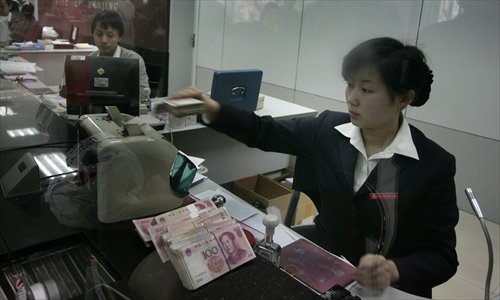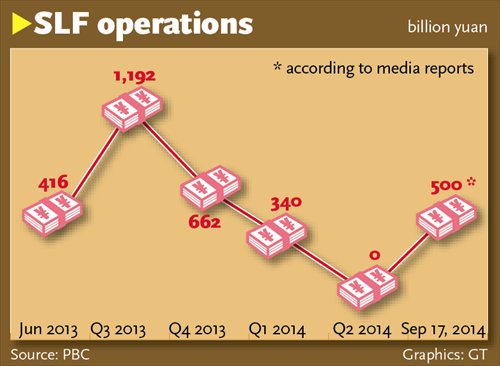HOME >> BUSINESS
Banks receive cash injection
By Li Qiaoyi Source:Global Times Published: 2014-9-18 0:13:01
PBC reportedly pumps 500b yuan into big five lenders

A bank staff counts money in an outlet in Nanjing, East China's Jiangsu Province. Photo: CFP

China' central bank is purportedly pumping a combined 500 billion yuan ($81.22 billion) into the nation's five top lenders, a move economists said Wednesday signifies policymakers' efforts to ramp up measures to revitalize the economy without being seen as adopting strong stimulus.
Speculations began circulating in the market late Tuesday that 100 billion yuan of liquidity is being injected into each of the Big Five State-owned banks via the Standing Lending Facility (SLF) with a tenor of three months.
The five lenders are Industrial and Commercial Bank of China, China Construction Bank, Bank of China, Agricultural Bank of China, and Bank of Communications.
The SLF was launched by the People's Bank of China (PBC), the country's central bank, at the beginning of 2013 as a supplementary liquidity management tool.
Stocks jumped on the reported move, with the Shanghai Composite Index ending up 0.49 percent on Wednesday and the Shenzhen Component Index rising 0.77 percent during the day.
The PBC didn't immediately respond to questions faxed by the Global Times seeking confirmation of the injection.
Market watchers have generally believed in the authenticity of the SLF injection.
"This should be real," Chen Wei, an analyst at Beijing-based brokerage house China Minzu Securities Co, told the Global Times on Wednesday. "The central bank wouldn't announce its injections through the SLF scheme until some time later, as previous operations showed."
Such an injection, tantamount to a 50 basis point cut in banks' reserve requirements, is a reflection of policymakers stepping up pro-growth measures to arrest a further slowdown in the economy, while avoiding to send a strong policy-easing signal, remarked Chen.
A raft of economic indicators for August released by the National Bureau of Statistics over the weekend showed weakness in the economy. Growth in the nation's factory output hit its lowest level in nearly six years in August, while urban fixed-assets investment growth continued a downward spiral during the first eight months of the year.
The data serves to stoke fears of a deeper downturn in the economy which is avowed to be resolutely on the path of reform.
The liquidity injection into the five biggest commercial banks, however, is seen as only having temporary influence, although it would diminish the case for a universal cut in reserve requirement ratio (RRR) or interest rates, economists said.
"The latest SLF is mainly aimed at providing liquidity to preempt potential liquidity shortages in the banking system in the coming weeks" due to factors that include the usual liquidity tightening at the end of the quarter and new IPOs mopping up investor liquidity, Chang Jian, chief China economist at Barclays Capital in Hong Kong, wrote in a note sent to the Global Times Wednesday. Chang believes the impact of the move on liquidity and equity market is probably just temporary.
Still, with the 500 billion yuan injection, the possibility of "a universal RRR or rate cut gets smaller," Lu Ting, China economist with Bank of America Merrill Lynch in Hong Kong, told the Global Times Wednesday in an e-mailed note.
"In the past the PBC would have cut both RRR and [interest] rates after getting activity data as poor as those in August, but the mandate of reforming and de-leveraging limits the room for maneuvering by the PBC," he said, emphasizing that these higher-profile policy actions might compromise the central government's messages for pressing ahead with broad-based economic reforms.
During his keynote speech delivered at the opening ceremony of the Summer Davos Forum in Tianjin on September 10, Premier Li Keqiang pledged the country will hold onto its prudent monetary policy and targeted measures rather than resort to strong stimulus or easing credit, despite fluctuations in the economic growth.
Posted in: Markets